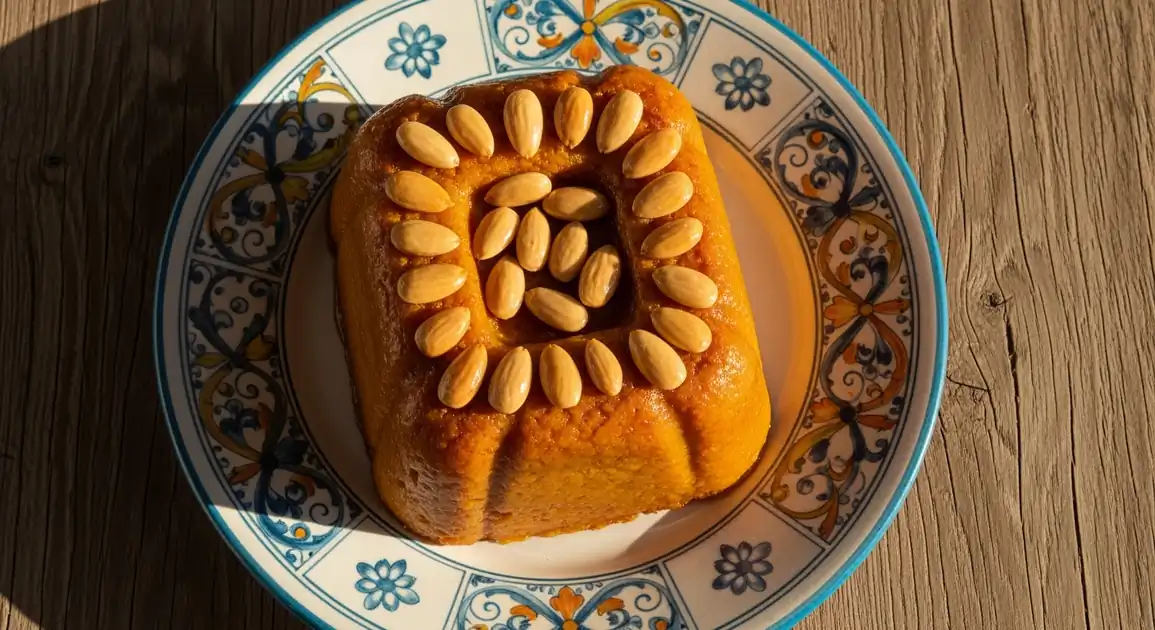Arnadi
Arnadí

Description
In Spain, Arnadi is primarily associated with the Valencia region and is part of the rich tapestry of regional desserts that vary significantly across the country. While it can occasionally be found in high-end Spanish restaurants in major cities featuring Valencian cuisine, it remains relatively unknown outside its home region, making it a true local specialty worth seeking out when visiting eastern Spain.
Dietary Information
Serving information
Serving style
Typically served as individual portions on small plates or paper doilies. Sometimes accompanied by a coffee or sweet wine in cafés and restaurants.
Quick facts
Bakeries typically operate from 8 AM - 2 PM and 5 PM - 8 PM, with many closed on Sunday afternoons.
Safety Tips
What to Look For
-
Natural, consistent light orange-yellow color
The natural color from pumpkin should be even and not overly bright or artificial-looking, indicating quality ingredients and proper preparation.
-
Freshly made with no signs of drying out or cracking
Quality Arnadi should have a smooth, moist texture. Cracks or dry edges suggest it's been stored too long.
-
Made in small batches rather than mass-produced
Artisanal bakeries making limited quantities tend to maintain higher quality and traditional methods.
-
Clean, well-maintained display cases with proper temperature control
Arnadi contains eggs and should be kept in refrigerated or cool conditions, especially in warmer months.
What to avoid
-
Bright orange or yellow artificial coloring
Authentic Arnadi has a natural, subtle color from real pumpkin. Vivid coloring indicates artificial additives.
-
Pre-packaged versions with long shelf life
Traditional Arnadi has limited preservatives and should be relatively fresh. Long shelf-life versions typically contain additives.
-
Overly wet or soggy texture
Proper Arnadi has a firm, flan-like consistency. Excessive moisture indicates poor preparation or quality issues.
-
Refrigerated items displayed next to unrefrigerated ones
Cross-contamination risks increase in places with poor food storage practices.
Price information
Price range
Budget tips
- Individual portions typically cost between 2-5 EUR at traditional bakeries.
- Prices are generally lower in neighborhood bakeries outside tourist areas.
- Some bakeries offer mini versions for around 1.50-2 EUR if you just want a taste.
Value indicators
- Made with local Valencian pumpkin varieties.
- Hand-shaped rather than mass-produced.
- Proper golden caramelization on the exterior.
- Generously topped with quality almonds.
- Smooth, even texture throughout.
Where to Find This Dish
Traditional Bakeries
Small, family-run pastelerías specializing in regional desserts are the best places to find authentic Arnadi.
Neighborhood bakeries, Artisanal pastry shops
Morning, Afternoon
Markets
Food markets with specialty dessert stalls often carry traditional sweets.
Municipal markets, Food halls
Morning, Early Afternoon
Cultural Festivals
During regional celebrations, especially around October 9 (Valencia Day).
City squares, Festival grounds
All Day during festivals
Vendor Tips
- Ask when they make fresh batches - some only prepare it on specific days.
- Look for places that use the Valencian spelling 'Arnadí' rather than the Castilian 'Arnadi'.
- Bakeries displaying the 'Artesano' (artisanal) designation often make more traditional versions.
How to Order
Regional Variations
-
Classic Arnadí
(Arnadí Tradicional)
The traditional version made with pumpkin and almond, shaped like a small cone or triangle, topped with toasted almonds.
-
Honey-Glazed Arnadí
(Arnadí con Miel)
Finished with a light honey glaze that adds extra sweetness and shine to the exterior.
-
Cinnamon Arnadí
(Arnadí con Canela)
With a stronger cinnamon flavor and sometimes a light dusting of cinnamon on top alongside the almonds.
-
Orange Blossom Arnadí
(Arnadí con Azahar)
Incorporates orange blossom water for a floral fragrance, reflecting another Moorish influence in Valencian sweets.
-
Sweet Potato Arnadí
(Arnadí de Boniato)
A variation using sweet potato instead of pumpkin, resulting in a slightly different flavor profile and deeper color.
Cultural context
History
Arnadi dates back to Moorish times in Spain (8th-15th centuries), reflecting the Arab influence on Valencian cuisine with its use of almonds and sweet pumpkin preparations. The dessert is particularly associated with the town of Xàtiva in Valencia province. Traditionally prepared for the feast of Sant Donís (October 9th), which coincides with Valencia Day celebrations, the dessert symbolizes the mountains of Valencia (particularly the Sierra de Aitana). It remains a treasured part of the region's pastry tradition, representing the blending of cultures that shaped Valencian identity.
Local significance
Arnadi represents the Moorish influence on Valencian cuisine and is particularly associated with the celebration of Sant Donís on October 9th, when it's traditionally given as a gift alongside marzipan fruits.
Eating customs
- Often enjoyed with afternoon coffee or as a dessert after the main meal.
- Traditionally eaten at room temperature rather than cold from refrigeration.
- Sometimes paired with sweet dessert wines from the region.